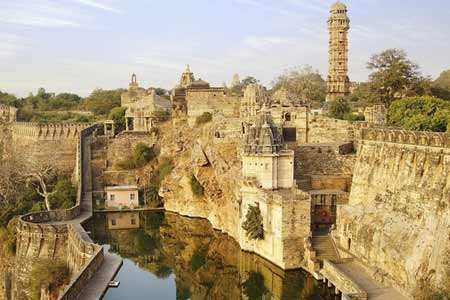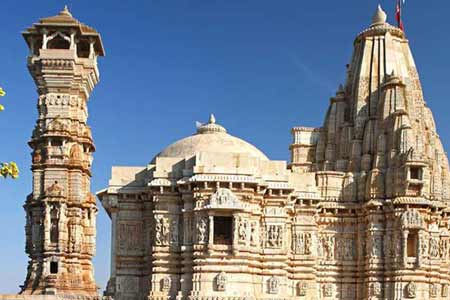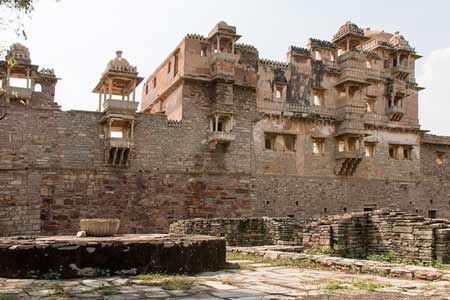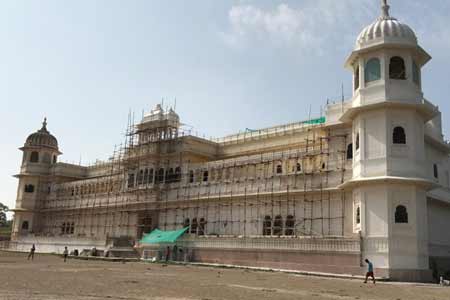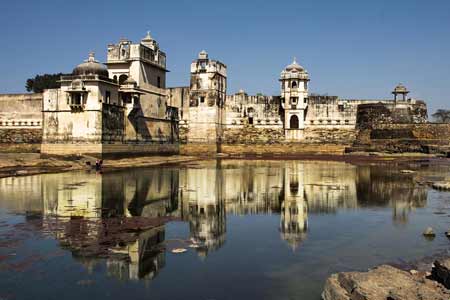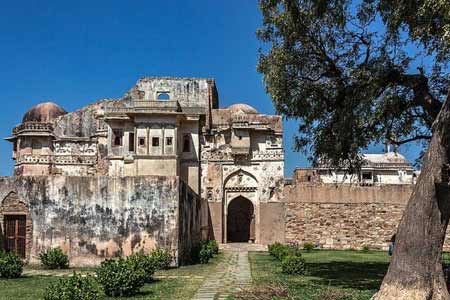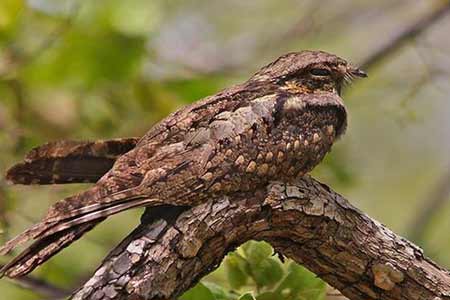
Vijay Stambh — Tower of Victory
Vijay Stambh (Tower of Victory) Chittorgarh, Rajasthan, India is the key among the tourist attractions in Chittorgarh. Built by Rana Kumbha in 1440 AD to celebrate his victory over Mahmud Khilji of Malwa, the tower is a must on your Chittorgarh tour. The star among the places of tourist interest in Chittorgarh, this tower is a marvel of architecture.
Vijay Stambh (Tower of Victory) Chittorgarh, Rajasthan, India is a 9-storied structure. With an imposing height of 37 meters, the monument is sure to inspire everyone on his Chittorgarh tour. Each of the story ids adorned with beautiful sculptures of Hindu divine beings. Indeed many on their visit to Chittorgarh regard it as the finest example of the famed Rajput style of architecture.
Its design and architecture points the agility of the craftsmen making it the most remarkable of the tourist attractions in Chittorgarh. The 157 circular and narrow steps led to the terrace. The tower is bedecked with sculptures of Hindu gods and scenes from the well known Ramayana and Mahabharata epics.
Vijay Stambh (Tower of Victory) Chittorgarh, Rajasthan, India is adjacent to the Mahasati area inside the Chittor fort. This spot is used as the cremation ground for the male members of the royal family. The surrounding area is dotted with Sati Stones signifying the sacrifices made by the women on their husbands' pyres.
Architectural Importance
Vijay Stambh of Chittorgarh is an inch by inch architectural marvel. It took a decade to build this magnificent structure. It is a high-rise square structure with a spiral staircase laid from the bottom to the last 9th stories of this tower. It stood at a height of 37.19 meters from a 10 feet citadel foundation. The entire structure is built with red sand stone and marbles. It is still unbelievable, that how did they build such high-rise structure in those days. Many architects believed that it was carved in a single stone on the ground and such nine huge single stone may be placed on after the other when the carving works are over from the ground. Whatever, no one in the present days can re built such towers even with all ultra modern techniques available now. It is a 9 storied structure with beautiful balconies and many arched open windows are seen all sides of this structure. There is a Sharpe peaked dome on the top with a semi sphere shaped dome. The first and the second story are built little larger to hold the rest of the floors. Again on the 8th floor there is a similar large sized structure found on the 1st and second floor. It is said that this was kept to have a vigil of Chittorgargh area. The entire structure is carved with Hindu ditties. There are also Vedic themes beautifully carved here. The vastu of ditties are also seen here. Each and every ditty is placed according to the Hindu principals and practice, which can be designed by an expert in the Hindu Vast Kala sashtra, i.e. the structural dynamics according to Hindu principals. A lot of precisions are sought here, which can be absorbed by only viewing from close of this structure.
Historical Importance
Vijay Stambh found in Chittorgarh are a very rear in India. It stood as a pride for the Rajputana Kingdom in Rajasthan. It was built around 1442 AD. The historians do believe that it was the pride over defeating an Islamic ruler of that time which was dreaming for the western expansion. At this time the Khilji Dynasty had the Northern, Eastern and Central India in its territory. The west ward approach was stopped by Rajput king Rana Kumbha. He also built a large fortification and a place in Chittorgarh to safe guard his kingdom from further external aggressions. In the later period this place was considered for royal crematorium for the male clans of this Mewar families. There are also many stone markings found here. This is believed to be the all those sacrificed their lives by performing Juhar, a self immolation by women's when they lost their husbands or a captive like situation emerged with enemy in the attack. All these history shows that the Rana Kumbha was a great devotee of Hindu culture.
Chittorgarh Tourist Attractions
The state of Rajasthan is culturally rich and has great historical importance. Chittorgarh is one of the popular destinations for tourist travel in Rajasthan. Chittorgarh city lies on the banks of Rivers Berach and Gambini. One of the significant landmarks in the city is the Chittorgarh fort. Once ruled by the Sisodia dynasty of Mewar, Chittorgarh is reminiscent of the brave kings who ruled this kingdom.
The fort of Chittorgarh was home to a fiercely independent clan of kings who fought off three invasions. Three times the women of Chittorgarh fort committed Johar. Some of the famous warriors of Chittorgarh include Jaimal, Phata, Badal and Gora who put up a tough battle against invaders such as Allaudin Khilji and the Mughals.
The wildlife sanctuary of Bassi is situated at a distance of 5kms from the Chittorgarh. This sanctuary, which sprawls over 50 sq km, is home to panthers, mongoose, wild boars and migratory birds. There are some other places of interest such as the Kalika Mata Temple, the Vijay Stambh, the Kirti Stambh, Rani Padmini’s Palace, Fateh Prakash Palace etc.
Chittorgarh is well connected to the rest of India by the Golden Quadrilateral highway system which passes through the city. The city of Chittorgarh lies by the NH 76 and 79. The state roadways have a regular bus service which can be used to reach Chittorgarh. The nearest railhead to the city of Chittorgarh is the Chittorgarh Railway Station. The nearest airport is Udaipur which is situated at a distance of 70 km from Chittorgarh.
 +91 9549279999
+91 9549279999 
